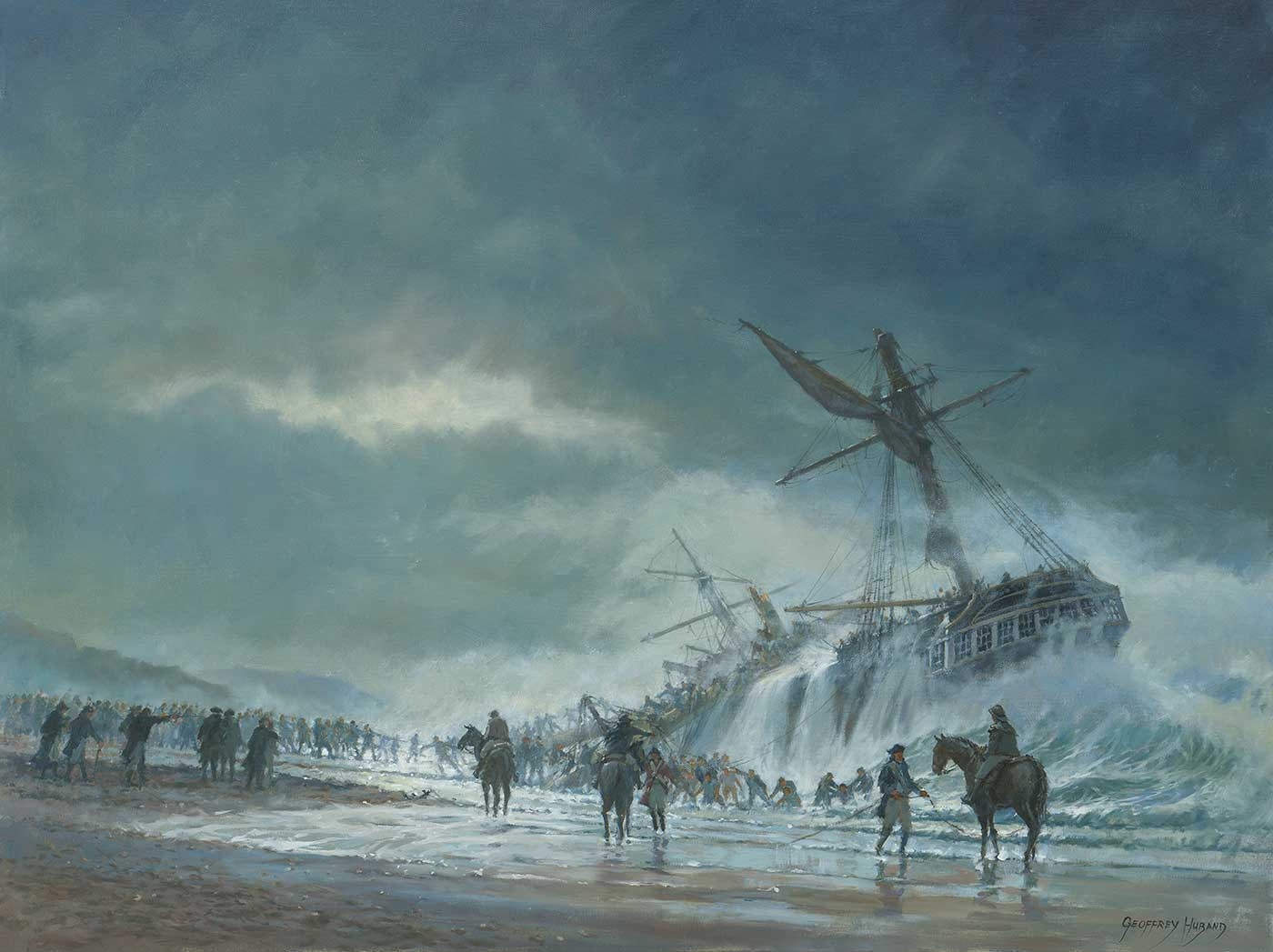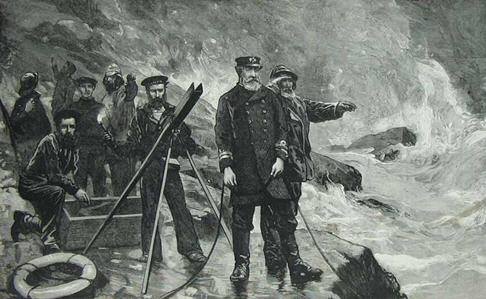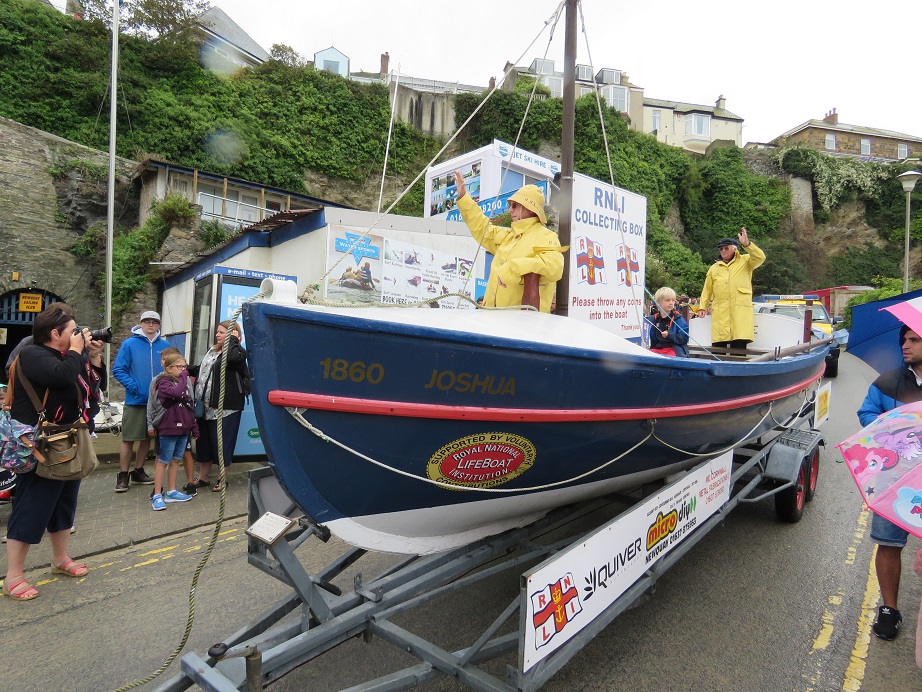Ertach Kernow - Cornwall's evolving means of saving life at sea
Cornwall's evolving means of saving life at sea: Cornish coastal waters whilst lovely in the summer sun can also be deadly. Rip tides and currents have caused the death of countless people drawn out to sea and lost. Rocks hiding below the surface have also been the cause of sinking many fine ships. More obvious are the storms with huge waves battering our coastline causing damage to coastal communities and creating mountainous waves further out to sea resulting in ships, especially in the days of sail, to founder or be swept to destruction on rocky shores.
Over two hundred years ago several people had been working on saving lives at sea when a vessel had been driven ashore and far too perilous for a rescue boat to reach even whilst those in danger were so close to shore. In 1807 George William Manby demonstrated his invention which became known as the ‘Manby Mortar’ which fired a line attached to a cannon ball and grappling hook to the vessel. This enabled people to reach the shore byway of a rope system. Here in Cornwall Henry Trengrouse had invented a rocket system which fired a rocket too which a line was attached. He had been horrified by the spectacle of drownings which he had observed when HMS Anson went aground in a storm on Looe Bar in 1807. His first thoughts were inventing a form of lifeboat but then created his rocket system. He would also invent a life jacket and a Bosuns Chair also known as a Breeches Buoy. John Dennet a resident of the Isle of Wight would improve on Trengrouse’s rocket in 1827. Rocket systems such as these would be found to be far more effective than the Manby Mortar and were used into the early 20th century.
Thank you for reading the online version of the Ertach Kernow weekly articles. These take some 12 hours each week to research, write and then upload to the website, and is unpaid. It would be most appreciated if you would take just a couple of minutes to complete the online survey marking five years of writing these weekly articles. Many thanks.
Click the link for survey: Ertach Kernow fifth anniversary survey link
As always click the images for larger view
The early coastguard of the Preventive Service had used the Manby Mortar and subsequent rocket systems to save lives. As time progressed there were many local groups formed as ‘Rocket Brigades’ or ‘Rocket Crews’ who undertook lifesaving from vessels wrecked close to shore through the use of these systems. Management of rocket apparatus was taken over by the Board of Trade in 1857 and by 1872 rocket brigades were established around the coat of Britain. This was particularly important to Cornwall with its long and dangerous coastline. Many ships began to carry their own portable systems and instructions were issued by the Board of Trade’s British Marine Department on how to operate the apparatus. Later in 19th century this role was partially taken over by the newly founded ‘National Institution for the Preservation of Life from Shipwreck,’ This organisation received a royal charter in 1860 and with that a name change to ‘Royal National Lifeboat Institution.’ Many will remember the use of maroons, rockets to alert lifeboat crews and also let those in danger know help is on the way. Technology and of course ubiquitous health and safety rules and regulations put an end to that tradition.
The Royal National Lifeboat Institution is now into its third century having been formed in 1824 in what was then a swanky London Tavern. It was as a result of his life on the Isle of Man and involvement in maritime rescue that Sir William Hillary drew up plans for a lifeboat service. Off to a somewhat subdued start it gained traction following support from a number of wealthy merchants and after royal patronage from King George IV. For Cornwall the benefits of what would become the RNLI were profound. With a coastline in excess 400 miles treacherous rocks around the Lizard, Land’s End and the Isles of Scilly’s and fully exposed to prevailing winds blown off the Atlantic Ocean the seas around Cornwall are potentially very dangerous.
Before lifeboats it was Cornish pilot gig’s which were often used to try and rescue crews from sinking ships. It was Bude who were the first Cornish recipients of a RNLI lifeboat in 1837 although there had been other earlier private lifesaving boats based around Penzance from 1803. Padstow had a lifeboat from 1825 but it wasn’t until 1856 that this was a RNLI vessel. The stations existing today gradually had lifeboats provided Lizard also in 1837, St Ives in 1840, Sennen in 1853, Fowey in 1859, Newquay in 1860, Looe in 1866, Falmouth in 1867 and Port Issac in 1869. A RNLI lifeboat at St Mary’s on the Isles of Scilly was provided in 1859. New lifeboat stations have opened at places with no previous RNLI history as coastal rescue needs change. Two 20th century stations at St Agnes (1968) and Rock (1994) are well situated for rescuing those inshore sport and tourism related incidents. The lifeboats have changed beyond all recognition from the early simple oar and sail powered vessels manned by hardy fishermen and mariners.
With today’s superbly designed lifeboats the crews of the latest vessels of the Shannon class, and their still current Tamar class (Padstow, Sennen, Lizard), Severn class (Falmouth, Penlee, St Mary’s IOS) and Trent class larger lifeboats, can be confident of their own safety. The larger Rigid inflatable lifeboats (RIBs) Atlantic 85 class are found at many Cornish ports such as Falmouth, Newquay, Penlee and Looe. The smaller D class and inshore rescue boats are far more suitable today around tourist beach areas and as secondary vessels.
Our Cornish lifeboats and their stations have evolved over the past near 200 years since the first boats began operating in Cornwall. The needs and requirements of lifesaving at sea have changed in ways our forefathers would never have imagined. Gone are the days of saving men from sailing vessels plying their trade around the long and often dangerous Cornish coast. The work of the early Cornish lifeboats has been replaced by rescue of an occasional private vessel, fishing boat and on few occasions much larger ships. Whilst some of the early Cornish stations no longer have deep sea offshore vessels, the mechanisation and increased speed of modern lifeboats of up to 25 knots located at nearby stations ensures good support.
New challenges have appeared from tourist with little understanding of the dangers of the sea, or perhaps just lack of common sense. Yes, the tide does come in and sometimes very quickly catching unwary beach goers to be cut off in isolated coves. Then there are the people who get into trouble off beaches whilst surfing, paddleboarding or messing about on inflatable craft. This is where the work of the beach lifeguards comes into its own, which too has evolved from the early voluntary work of groups including local surf lifesaving clubs. In the 1950’s four surf lifesaving clubs began beach patrols at Bude (1953) St Agnes (1954) Brighton (1954) and Perranporth (1957). Members of Bude and St Agnes formed The Surf Life Saving Association of Great Britain, in 1955. Cornwall was at the forefront of this aspect of saving life at sea with British Life Saving Championships held on Cornish beaches in the 1960’s. Bude were the winners in 1966 at the championship held at Newquay.
This service was limited by local resources although councils in Cornwall had been employing professional lifeguards since the late 1950 due to the number of drownings each year. All of a sudden there were Australians and Americans coming to Cornwall to work as lifeguards and this in turn had the effect of evolving surf culture. Local Newquay people will remember some of these characters such as Mike Irwin best known as Phantom or just Phant. Many of these arrived around 1962 and settled here and continued to come to work and of course play hard over the succeeding decades. The unusual death of young Australian lifeguard Karl Edwards in June 1986 due to a cliff slide onto the lifeguard hut on Towan Beach Newquay during a storm was a tragedy. He is still remembered by many with the steps going down to the beach known as ‘Karl’s Steps.’
It was in 2001 the RNLI accepted the baton of organising and extending beach lifeguard lifesaving duties. Today over twenty beaches in Cornwall are patrolled by RNLI lifeguards and some 240 throughout the United Kingdom. Many lifeguards are paid by relevant local authorities but there are still many volunteers providing backup services. They say prevention is better than cure and this is the case of beach lifeguards who also educate people on beach and water safety as well as dispensing information and other advice including returning lost children to their parents.
These days during the summer months many communities commemorate and support their local lifeboat and their crews by holding a ‘Lifeboat Day’ event. Not only does this remind people of the work carried out mainly by volunteers in saving lives but also raising money to support what is a charity brought into being to save lives at sea. Hopefully it also draws the attention of the vast numbers of people moving to Cornwall often from inland areas of England of the dangerous Cornish waters and local lifeboat history. Cornwall must thank those who help raise money for the RNLI through events and also their regular voluntary contribution by manning lifeboat shops and those conducting tours of lifeboat stations creating improved awareness.
With the summer season well upon us no doubt our local lifeboat volunteers and beach lifeguards are already in action. The history of the Cornwall’s lifeboats and their crews have entered Cornish historical heritage and as saving life at sea evolves so too will the lifeguards of the past decades. The men who have manned the coastguard stations for two centuries and those who clambered down cliffs and fired the rockets as part of the Rocket Brigades all have their part in saving lives around the Cornish coast and should be remembered.














